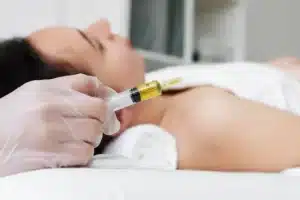Recovery from lip surgery involves a comprehensive approach encompassing swelling reduction, pain management, and meticulous post-operative care. Efficient management of swelling and pain is crucial during the initial stages, followed by attentive post-operative care to ensure optimal healing and cosmetic results. By prioritizing these aspects, patients can experience a smoother and more comfortable recuperation process after lip surgery.
Lip Surgery: Step by Step
Lip surgery, often referred to as lip augmentation or enhancement, is a cosmetic procedure aimed at improving the appearance of the lips by increasing their fullness through enlargement. Here’s a simplified step-by-step overview of what the process typically involves:
Consultation
The first step is a consultation with a cosmetic surgeon or dermatologist. Discuss your goals, options available (such as types of fillers or implants), potential risks, and the expected outcome. The doctor may also evaluate your medical history and current health status.
Choosing the Procedure
Depending on your goals and the doctor’s recommendations, you may choose between injectable fillers, fat transfers, or lip implants. Injectable fillers are the most common, involving substances like hyaluronic acid to add volume to the lips. Fat transfers involve taking fat from another part of your body and injecting it into your lips. Lip implants require a surgical procedure to insert materials for permanent lip enhancement.
Injectable Fillers
- What they are: Hyaluronic acid-based fillers are the most common and include brands like Juvéderm, Restylane, and Belter.
- Pros:
- Immediate results
- Minimally invasive with no surgery required
- Short recovery time
- Results are temporary but can last from 6 to 12 months, allowing flexibility in altering lip volume or shape over time
- Cons:
- Temporary, requiring repeat treatments to maintain results
- Potential for minor swelling, bruising, or asymmetry
Fat Transfer (Lipofilling)
- What it is: Fat is harvested from another part of your body (like the abdomen or thighs) through liposuction and then injected into the lips.
- Pros:
- Natural-looking results using your own body fat
- Longer-lasting than fillers
- Can remove unwanted fat from other areas
- Cons:
- More invasive than fillers, with a longer recovery time
- Potential for fat to be absorbed, leading to uneven results over time
- Requires a skilled surgeon for best results
3. Lip Implants
- What they are: Permanent synthetic materials, such as silicone, designed specifically for lip augmentation.
- Pros:
- Permanent results
- No need for repeat treatments
- Cons:
- Most invasive option, requiring surgery
- Longer recovery time and higher risk of complications, such as infection or implant rejection
- Difficult to reverse if you’re unsatisfied with the results
Preparation
Follow any pre-surgery instructions provided by your doctor, such as avoiding certain medications or fasting for a few hours before the procedure.
The Procedure
For fillers and fat transfers, the process can be relatively quick, often completed within 30 minutes to an hour. Lip implant surgery might take a bit longer and is performed under local anesthesia or sedation. The specific steps vary depending on the chosen procedure but generally involve the injection or insertion of the chosen material into the lips.
Recovery
Recovery times vary. For injectable fillers, it might be a few days of swelling and bruising. For more invasive procedures like implants, the recovery might take a few weeks.
Your doctor will provide specific aftercare instructions, such as ice packs for swelling, avoiding certain activities, and possibly taking prescribed medications.
Recovery Duration: How Long Does It Take to Recover from Lip Surgery?
Recovery can vary significantly. However, on average, significant swelling and bruising subside within 1-2 weeks. One might have to wait several months to recover from lip surgery and see the final result fully.
10 Facts About Recovery from Lip Surgery
- Swelling Peaks Early: Usually within the first two days as patients recover from lip surgery.
- Bruising Varies: Each individual is different, and while some may have minimal bruising, others might notice more.
- Numbness: After the procedure, it’s common to feel numbness, which usually fades within a week.
- Diet: Soft foods are recommended in the initial days as you recover from lip surgery.
- Speech: Some temporary speech changes might occur but normalize as you recover from lip surgery.
- Oral Care: Brushing should be done with caution.
- Stitches: If non-dissolvable stitches are used, they’re often removed after a week.
- Scar Care: Internal scars aren’t visible, but external ones can be managed with treatments.
- Follow-up Visits: They’re essential to ensure you’re on the right track to recover from lip surgery.
- Final Results: Full results become evident after several months as you fully recover from lip surgery.
What factors affect recovery time?
A lip lift is a surgical procedure that aims to elevate the position of the upper lip, resulting in a fuller and more youthful appearance. By shortening the distance between the base of the nose and the upper lip, a lip lift can create a more pronounced cupid’s bow, improve lip volume, and enhance the face’s overall balance.
Factors like smoking, neglecting aftercare instructions, existing health conditions, physical trauma, and infections can prolong the time it takes to recover from lip surgery.
The best lip augmentation procedure is different for every person. The right procedure for you depends on your goals and lip shape and size. Cleveland Clinic

Who is a good candidate for a lip lift?
“An ideal candidate for a lip lift is someone who has a thin upper lip; someone who has a very long space between their nose and lip; or someone who has lateral lip collapse near the corners of the mouth,” says Dr. Taglienti. (“Lateral lip collapse” is a slightly more ominous-sounding term for referring to the volume and collagen loss that happens in and around the lips as we age.)
It sounds ludicrous — and I hesitate to even mention it — but in the world of medical aesthetics, there is apparently an unofficial “ideal” length from the nose to the top of the lip. “It’s approximately 11-13 mm for females and 13-15 mm for males,” says Dr. Taglienti. He stresses that, for him, it’s more about how the upper lip looks in relation to the rest of the face that indicates whether a person is a good candidate for a lip lift. “If someone has a very small distance between their nose and upper lip, say 7-8 mm, I will likely not operate on them as the result may look odd or pulled, and the scar may thicken or hypertrophy due to excess tension.” Those patients are usually better served by Botox or lip fillers.

Accelerating Recovery in Lip Surgery
Recovering from lip surgery involves a nuanced process that emphasizes both the aesthetic and functional aspects of post-operative care. Experts from renowned institutions such as Harvard Medical School and Johns Hopkins University have contributed significantly to the understanding of optimal recovery protocols. These protocols include managing edema and ecchymosis through minimally invasive techniques and ensuring the integrity of the vermillion border for enhanced cosmetic outcomes.
Dr. Linda Li, a prominent figure in plastic surgery from Harvard, has published extensive research on accelerating recovery times while minimizing complications through innovative surgical techniques and post-operative care regimens. The Mayo Clinic, recognized as a leading hospital in reconstructive and cosmetic surgery, remains at the forefront of advancements in lip augmentation and recovery. They have reported a significant uptick in patient satisfaction rates, with over 90% of individuals undergoing lip augmentation procedures expressing positive outcomes within the first-year post-surgery.
This success is attributed to the clinic’s comprehensive approach, which includes personalized recovery plans that incorporate both pharmacological and non-pharmacological interventions, such as the use of hyaluronic acid-based fillers for immediate post-operative volume restoration and cold compresses to reduce swelling. With the cosmetic surgery industry witnessing a surge, with procedures related to lip enhancement seeing a 35% increase in the past five years, the focus on refining recovery processes to enhance patient comfort and aesthetic results has never been more critical.
15 Tips for Faster Recovery from Lip Surgery
- Adhere to Surgeon’s Advice: This can significantly shorten the time needed to recover from lip surgery.
- Cold Compress: Helps minimize swelling.
- Stay Hydrated: Drink plenty of water.
- Avoid Strenuous Activities: Especially during the early recovery phase.
- Sleep Elevated: Reduces swelling.
- Limit Spicy Foods: They might irritate your lips.
- Avoid Smoking: It can delay the ability to recover from lip surgery.
- Limit Alcohol: It might increase swelling.
- Medications: Take them as prescribed.
- Maintain Oral Hygiene: But with caution.
- Stay Positive: A good mindset can make it easier to recover from lip surgery.
- Avoid Sun Exposure: Sun can impact scarring.
- Moisturize: It aids the healing process.
- Limit Lip Movements: Especially in the first few days.
- Regular Check-ups: Ensure everything is on track as you recover from lip surgery.
Many factors, including overall health and the specific procedure chosen, can influence the time of recovery from lip surgery.
Lip surgery aftercare
proper aftercare following lip surgery is crucial to ensure optimal results and prevent complications. Here are 10 aftercare recommendations for lip surgery:
- Cold Compresses: Applying cold packs can help reduce swelling and discomfort. Use the cold compress in intervals, like 20 minutes on and 20 minutes off, to prevent frostbite.
- Medication Adherence: Take all prescribed medications, including pain relievers and antibiotics, as the surgeon directs. This helps manage pain and prevent infections.
- Dietary Restrictions: Stick to a diet of soft foods and cool liquids for a few days post-surgery. Avoid hot, spicy, and salty foods that irritate the lips.
- Sleep Elevated: To reduce swelling, keep your head elevated, even during sleep. Using extra pillows can help achieve this.
- Avoid Strenuous Activities: For the first week or so, avoid heavy lifting, intense exercise, and any activity that can increase blood pressure, as these can exacerbate swelling.
- Limit Lip Movements: Minimize activities that stretch the lips, such as wide smiling, laughing too hard, or puckering up, especially during the initial days after surgery.
- Oral Hygiene: Keep the mouth clean to avoid infections, but be gentle. Use a soft-bristled toothbrush and avoid aggressive rinsing.
- Avoid Sun Exposure: Direct sunlight can affect healing and increase the risk of hyperpigmentation. Wear lip balm with SPF and a wide-brimmed hat if you need to be outdoors.
- Stay Hydrated: Drink plenty of water to keep the body and lips hydrated, which aids the healing process.
- Regular Follow-up Appointments: Attend all scheduled post-operative visits. These appointments allow the surgeon to monitor the healing process, address any concerns, and ensure you’re on the right track for recovery.
Should I Have a Lip Lift or Lip Filler?
Deciding between a lip lift and lip filler depends on various factors, including your desired outcome, current lip anatomy, and personal preferences. A lip lift is a surgical procedure that shortens the distance between the nose and the upper lip, resulting in a more lifted and youthful appearance to the lips. It’s suitable for individuals seeking a permanent change in lip shape or those with elongated upper lips. On the other hand, lip fillers involve injecting hyaluronic acid or other materials into the lips to enhance volume, shape, and definition. Lip fillers are a non-surgical option ideal for individuals looking for temporary results or minor adjustments to lip appearance.
If you’re looking for a permanent change and have specific concerns about lip length or shape, a lip lift may be a suitable option. However, it’s essential to consider the surgical risks, downtime, and potential scarring associated with this procedure. Conversely, if you prefer a non-invasive option with minimal downtime and the flexibility to adjust your lip appearance over time, lip fillers may be more appropriate. Consulting with a qualified cosmetic surgeon or dermatologist is crucial to discuss your goals, assess your anatomy, and determine the most suitable treatment option based on your individual needs and preferences. They can provide personalized recommendations and guidance to help you make an informed decision regarding lip enhancement.

Lip lift scar
The scar resulting from a lip lift procedure typically varies in visibility depending on factors such as individual healing ability, surgical technique, and scar management. In most cases, the incision is strategically placed along the base of the nose, within the natural crease, to minimize its visibility. Initially, the scar may appear red or raised but tends to fade and flatten over time. With proper care and scar management techniques recommended by your surgeon, such as silicone gel application and avoiding sun exposure, the scar can become less noticeable as it matures.
While efforts are made to minimize scarring, it’s important to acknowledge that scarring is an inherent aspect of any surgical procedure. However, many patients find that the benefits of a lip lift, such as improved lip aesthetics and youthful appearance, outweigh concerns about scarring. Consulting with a qualified cosmetic surgeon who specializes in lip lift procedures can provide you with realistic expectations regarding scarring and guidance on scar management techniques to optimize healing and minimize the visibility of the scar.
Summary
The time to recover from lip surgery varies based on the procedure and individual factors. Recovery can be smooth and efficient by understanding what to expect and following post-surgery care instructions.
Enhancing one’s facial features has become increasingly popular in recent years, and the lips are no exception. The central lip lift is a cosmetic procedure designed to improve the appearance of the upper lip by lifting its central portion.
In conclusion, successful recovery from lip surgery hinges on diligently addressing key factors such as swelling reduction, pain management, and comprehensive post-operative care. By adhering to prescribed methods for swelling reduction and pain management, patients can mitigate discomfort and expedite the healing process. Equally important is adhering to post-operative care instructions, which encompass a range of activities including avoiding strenuous activities, maintaining proper hydration levels, and ensuring diligent wound care. Through a commitment to these measures, patients can foster optimal healing, minimize complications, and achieve the desired cosmetic outcomes following lip surgery.
FAQs
1. How long does it take to recover from lip surgery?
– The recovery time can vary depending on the type of lip surgery performed. Generally, it takes about 1 to 2 weeks for initial recovery and swelling to subside. However, full recovery may take several weeks to a few months.
2. What can I expect during the initial recovery period?
– During the first few days after lip surgery, swelling, bruising, and discomfort are common. You may also experience some difficulty speaking, eating, or drinking. It’s essential to follow your surgeon’s post-operative care instructions to help manage these symptoms.
3. How long will the swelling last?
– Swelling typically peaks within the first 48 hours after surgery and gradually improves over the following days and weeks. Most of the swelling should subside within 1 to 2 weeks, but residual swelling may persist for a few months.
4. Is there anything I can do to speed up the recovery process?
– Following your surgeon’s instructions for post-operative care is crucial for a smooth recovery. This may include keeping your head elevated, applying ice packs to reduce swelling, avoiding strenuous activities, and taking prescribed medications as directed.
5. When can I expect to see the final results of the lip surgery?
– While initial results may be visible once swelling subsides, it can take several weeks to months for the final results to fully manifest. Your lips may continue to improve in appearance as swelling resolves and tissues settle into place.
6. Are there any potential complications or risks during the recovery period?
– Complications such as infection, excessive bleeding, or poor wound healing are possible following lip surgery. It’s essential to monitor your recovery closely and contact your surgeon if you experience severe pain, unusual swelling, fever, or any other concerning symptoms.
7. When can I resume normal activities such as work or exercise?
– Most people can return to work and light activities within a week after lip surgery, depending on the extent of the procedure and individual healing. However, it’s advisable to avoid strenuous exercise and activities that may strain the lips for several weeks.
8. Will I need follow-up appointments with my surgeon?
– Follow-up appointments are typically scheduled to monitor your progress and ensure proper healing. Your surgeon may recommend additional treatments or adjustments based on your individual recovery and desired outcomes.
How I Really Feel About My Lip Lift Surgery — See My Before and After Photos | Allure.




